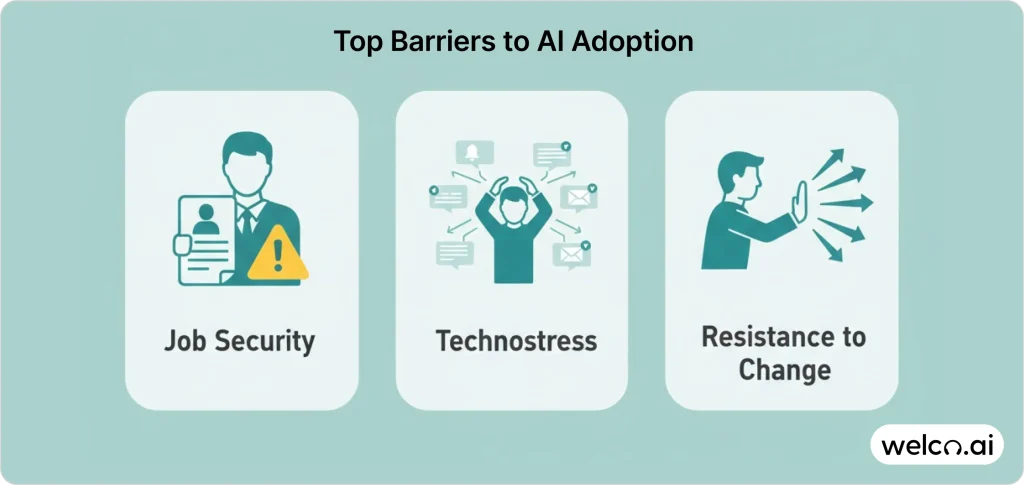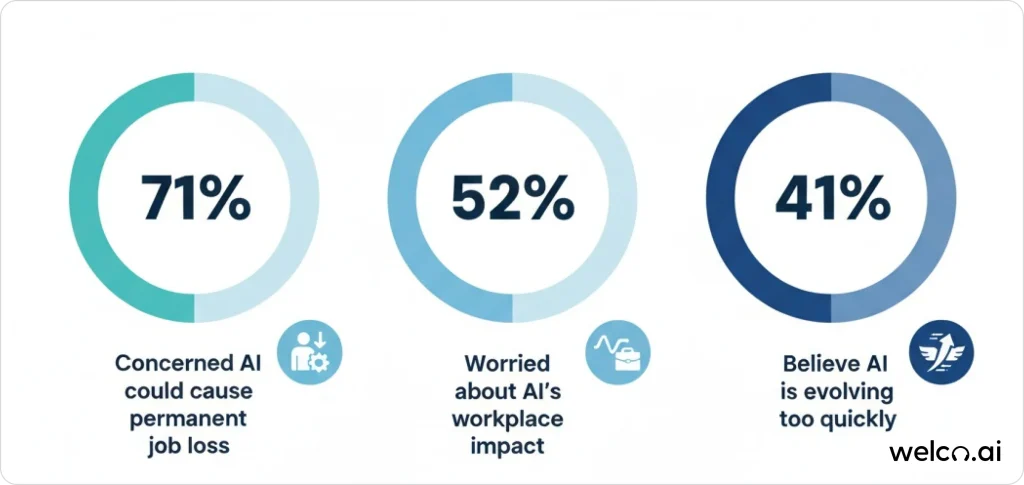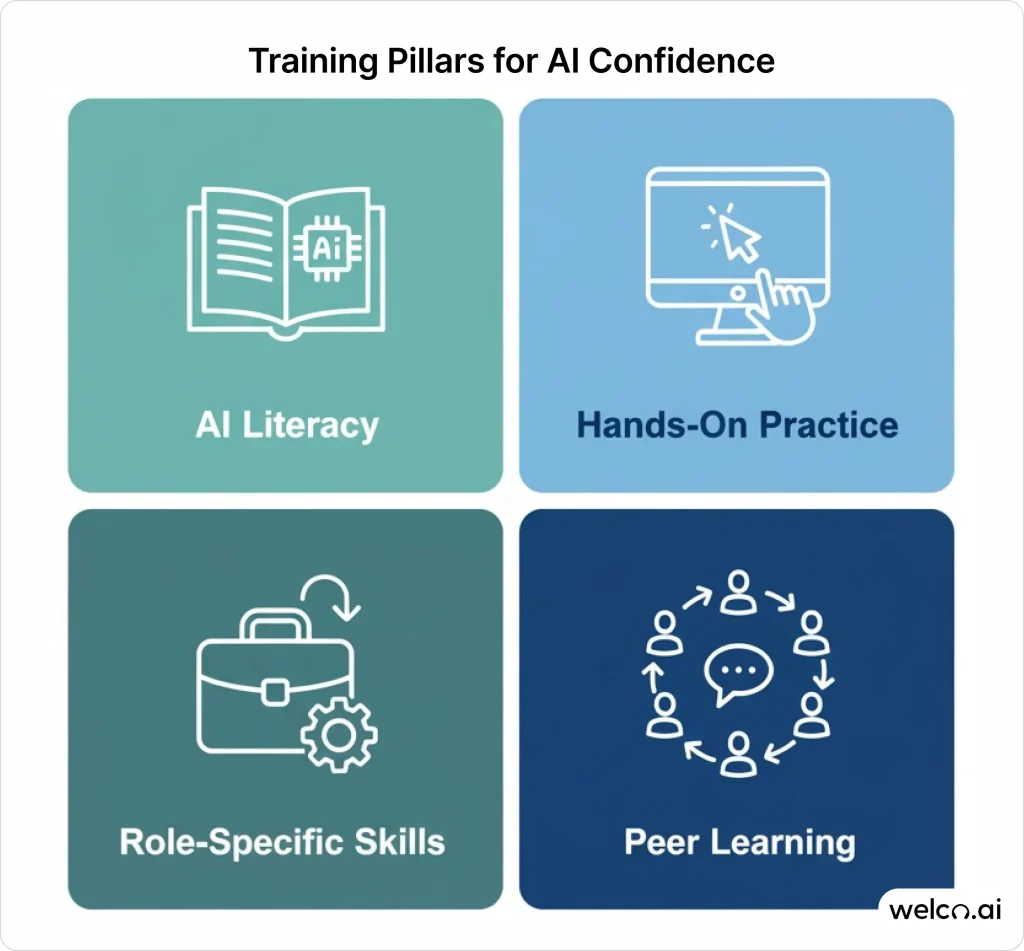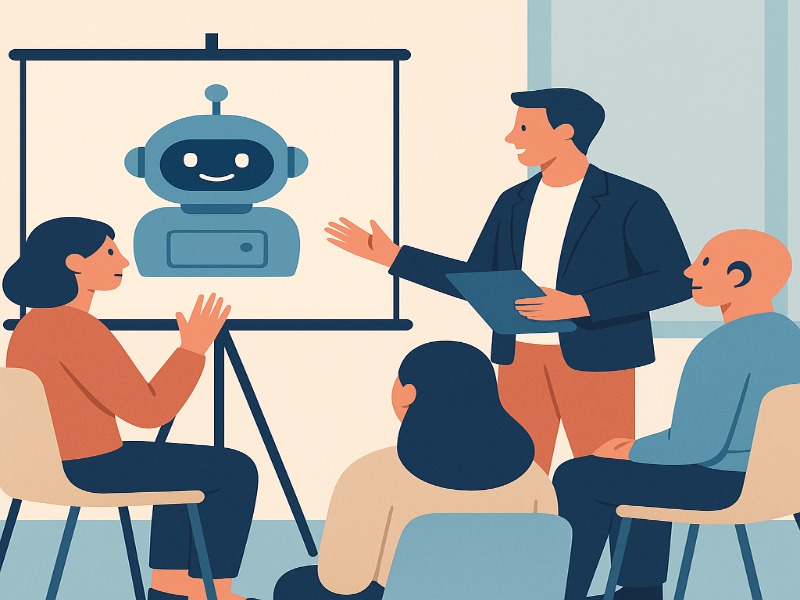Ever notice how conference rooms go quiet when someone mentions “AI training”? You’re not alone. Overcoming AI anxiety has become one of the biggest challenges facing HR leaders today.
Here’s a stat to prove it:
71% of Americans express concern that artificial intelligence could cause permanent job loss. Meanwhile, 52% of US employees are genuinely worried about AI’s impact on the future of the workplace. That’s not just fear; that’s widespread workplace anxiety that demands immediate attention.
But here’s the thing: Organizations that address AI anxiety head-on see dramatically better adoption rates and employee satisfaction.

This guide shows you exactly how to transform worried teams into confident AI collaborators.
Why Employees Feel Anxious About AI
The psychology behind AI resistance isn’t complicated. When humans encounter potential threats to their survival—in modern terms, their livelihood- their brains trigger predictable responses.
Understanding why people resist AI helps you address concerns before they become organizational roadblocks.
Key barriers to AI adoption
Three primary fears drive AI resistance in the workplace: job displacement anxiety, technological overwhelm, and loss of workplace control. Each barrier requires a different approach, but all stem from the same root cause, i.e., uncertainty about the future.

Job security fears
Job security concerns are obvious but critical. 24% of employees are concerned AI will make certain jobs obsolete. When displacement feels personal and immediate, resistance becomes inevitable.
But here’s what most people miss.
The World Economic Forum projects that sectors like AI will create 170 million new jobs globally while eliminating 92 million others. That’s a net gain of 78 million positions by 2030. The key is helping employees see AI as a job evolution, not job elimination.
Technostress & uncertainty
Information overload hits differently when it involves your career. Employees feel overwhelmed by the constant stream of AI updates, new tools, and changing requirements.
According to a survey by EY, 71% of employees are concerned about AI. About 48% of respondents said they are more concerned about AI today than they were a year ago, and of those, 41% believe it is evolving too quickly.
This challenge isn’t just about learning new software. It’s about adapting to an entirely new way of working while everything around you shifts constantly.
Resistance to change
Change resistance runs deeper than simple stubbornness. When AI implementation alters team dynamics, decision-making processes, and daily workflows, employees lose their sense of control and competence.
Only 29.5% employees feel fully supported in adapting to AI-driven workplace changes. That support gap creates anxiety that spreads through teams like wildfire. The solution to this problem is to meet this resistance towards AI with empathy, not dismissal.
These three barriers: job security fears, technological stress, and change resistance, form the foundation of AI anxiety. Address each one of these systematically, and you’ll transform worried employees into confident AI collaborators.
Building Trust With Transparent Communication
Transparency kills AI anxiety faster than any training program.

42.5 percent of respondents in a workforce survey by Piktochart believed their company was doing enough to prepare staff for a future with AI. The other 29.5 percent of respondents believed their company was doing somewhat enough to prepare staff.
However, transparency means more than sending company-wide emails about AI adoption. It requires honest, ongoing dialogue about what’s changing, why it matters, and how it affects individual roles.
The following are the communication strategies that actually work:
Start early and often: Begin AI conversations before implementation, not after. Share specifics about which tasks AI will handle and how it enhances rather than replaces current roles.
Address privacy head-on: Explain exactly what data AI systems access, how it’s processed, and who controls it. 77% of employees worry about legal risks with AI, so detailed privacy explanations build immediate trust.
Create feedback loops: Establish regular forums where employees can voice concerns, ask questions, and get real answers. When people feel heard, anxiety naturally decreases.
Remember: employees don’t fear AI itself. They fear the unknown. Transparency eliminates the unknown.
Early communication, privacy clarity, and ongoing feedback loops create the trust foundation necessary for successful AI adoption. When employees understand what’s happening and why, anxiety naturally transforms into curiosity.

Practical Change Management & HR Strategies
HR sits at the center of successful AI adoption. If you are an HR professional, your role extends far beyond training coordination; you are the bridge between technological capabilities and human needs.
Below is what effective change management looks like in practice:
Involve employees in pilots: Don’t implement AI and hope for acceptance. Include staff in tool selection, workflow design, and feedback collection. When employees help shape AI adoption, they become stakeholders instead of skeptics.
Support emotional well-being: Nearly half of employees experiencing AI anxiety see declining mental health. Provide stress management resources, counseling support, and regular check-ins that address both technical and emotional challenges.
Communicate everything with clarity: Share implementation timelines, training schedules, and success metrics. Uncertainty breeds anxiety, so overcommunicate rather than underinform them.
The organizations that succeed treat AI adoption as a human transformation, not just a technical upgrade.
Employee involvement, emotional support, and clear communication form the three pillars of effective AI change management. Master these elements, and your implementation timeline shrinks while satisfaction scores soar.
Training for Human-AI Collaboration
Effective AI training goes beyond tool tutorials. You are building digital literacy, critical thinking skills, and collaboration competencies that will evolve with technology.
The following are the ways to structure training that works:
Build core AI literacy for everyone: Start with fundamentals: what AI can and can’t do, how it makes decisions, and where human oversight remains essential. Demystify the technology before diving into applications.
Provide hands-on practice: Abstract concepts mean nothing without practical experience. Create safe environments where employees can experiment with AI tools, make mistakes, and learn through trial and error.
Make it role-specific: Marketing teams need different AI skills than customer service representatives. Customize training content to address actual job functions and daily challenges.
Encourage peer learning: Some of your best AI champions aren’t in IT; they are the curious employees who have already started experimenting. Create communities where these early adopters can share insights and support their colleagues.
Remember: confidence comes from competence. The more comfortable employees become with AI tools, the less anxious they feel about AI adoption.
Core literacy, hands-on practice, role-specific training, and peer learning create a comprehensive foundation for AI competence. This four-pillar approach ensures no employee gets left behind during the transition.
Empowering Staff: Champions & Open Feedback
Every team has natural influencers; the people others turn to for advice and support. These individuals become your most powerful assets during AI adoption.
Select the right champions: Look for employees who combine technical curiosity with strong interpersonal skills. They don’t need to be AI experts, but they should demonstrate genuine interest in learning and helping others.
Train champions thoroughly: Provide deeper technical knowledge than general employee training, plus coaching skills for peer support. Champions need to answer questions, address concerns, and demonstrate AI benefits through their own work.
Create champion communities: Connect champions across departments so they can share best practices, solve problems collaboratively, and maintain momentum during challenging phases.
For feedback systems, establish multiple channels that accommodate different communication preferences as below:
- Regular pulse surveys tracking comfort levels and specific challenges
- Anonymous suggestion platforms for honest input without fear of repercussions
- Open forums where teams can discuss AI applications and share tips
When employees feel heard and supported by their peers, resistance transforms into engagement.
Champion selection, thorough training, community building, and systematic feedback collection create a support network that sustains AI adoption long after initial training ends. These human connections often matter more than the technology itself.
Real-World Use Cases of AI Adoption and Early Successes
Concrete examples overcome skepticism faster than any training presentation.
The following are examples of how successful AI implementation looks across different industries:
Healthcare transformation:
A government health agency implemented AI-driven training platforms that adapted to individual expertise levels.
This AI-based system provided real-time performance insights while customizing content for pandemic response and mental health protocols. It helped reduce 40% reduction in training time with significantly improved knowledge retention.
Legal innovation:
Law firms using AI for research and document review report 50% faster case preparation times. The key is maintaining human oversight while utilizing AI for pattern recognition and initial analysis.
These aren’t isolated success stories. They’re examples of what happens when organizations prioritize employee support alongside technological implementation.
Healthcare efficiency, legal innovation, and service industry transformation demonstrate AI’s practical value across sectors. The common thread? Each success story prioritized human adaptation alongside technological capability.
Maintaining Human Oversight in AI Workflows
The most successful AI implementations don’t replace human judgment; they enhance it. Effective hybrid workflows leverage AI for pattern recognition and data processing while preserving human control over complex decisions.
The following are the ways to ensure your organization has balanced human-AI collaboration:
Map clear responsibilities: AI handles routine calculations, data analysis, and initial content generation. Humans manage strategic planning, relationship building, and ethical decision-making. When you define roles clearly, anxiety about job displacement decreases.
Establish escalation protocols: Create systematic procedures for when AI recommendations require human review. High-impact decisions, unusual circumstances, and ethical concerns should always involve human oversight.
Maintain quality control: Implement regular auditing of AI-assisted decisions to identify patterns, errors, or biases that require correction to build trust while ensuring AI systems remain accurate and fair.
Remember: you are not choosing between humans and AI. You are creating partnerships that leverage the best of both.
Clear role mapping, systematic escalation procedures, and quality control processes ensure AI enhances human capabilities without replacing human judgment. This balanced approach reduces anxiety while maximizing efficiency.
Measuring AI Implementation Success
Track the metrics that matter for both business outcomes and employee experience:
Adoption rates: Monitor not just who’s using AI tools, but how frequently and effectively they are applying them to real work challenges.
Employee satisfaction: Regular surveys should track comfort levels, confidence with AI tools, and overall job satisfaction during the transition period.
Productivity improvements: Measure concrete outcomes like task completion times, error rates, and quality improvements that demonstrate AI’s practical value.
Engagement indicators: Track participation in training programs, contribution to improvement suggestions, and peer-to-peer knowledge sharing.

The goal isn’t perfect metrics; it’s continuous improvement based on real employee feedback and business results.
Tracking adoption rates, satisfaction levels, productivity gains, and engagement indicators provides the data foundation for ongoing AI optimization. Regular measurement ensures your implementation stays aligned with both business goals and employee needs.
Welco’s Approach: Streamlined AI Integration
Welco addresses the specific challenges outlined throughout this guide with features designed for smooth employee adoption.
The platform provides 24/7 support that eliminates the anxiety of being stuck without help. When employees know assistance is always available, they’re more willing to experiment and learn.
Role-based training means employees get relevant, applicable instruction rather than generic AI overviews. Marketing professionals see AI applications for their daily work, while customer service teams focus on conversation enhancement and response optimization.
Quick onboarding reduces the overwhelming feeling that often accompanies new technology adoption. Instead of months-long implementation periods, teams start seeing AI benefits within weeks.
Why organizations choose Welco for AI anxiety reduction:
Unlike generic AI platforms that overwhelm teams with complex features, Welco focuses on a 30-minute setup vs. months with traditional AI implementations
- Industry-specific scenarios for healthcare, legal, retail, and professional services
- Seamless integrations with existing workflows and communication systems
- Scalable support that grows with your team’s AI confidence
- Proven anxiety reduction through guided, supportive implementation
Organizations using Welco report 95% user satisfaction rates with AI assistance quality and 85% of employees feeling confident in their AI collaboration skills within three months of implementation.Ready to transform your team’s AI relationship? The transition from AI anxiety to AI advocacy doesn’t have to take months. With the right approach and support system, you’ll build employee confidence, improve productivity, and create lasting AI adoption—all while keeping your team engaged and supported throughout the journey.
Getting Ready for the AI Future
The organizations that thrive with AI are not the ones with the most advanced technology. They are the ones that master human-AI collaboration.
Overcoming AI anxiety requires more than training programs and communication plans. It demands genuine commitment to employee experience, ongoing support for adaptation, and recognition that successful AI implementation is fundamentally a human challenge.
Your employees are ready for this transformation. They want training, support, and clarity about their role in an AI-enhanced workplace. When you provide these foundations, anxiety transforms into excitement.
The future belongs to organizations that see AI adoption as an opportunity to enhance human capabilities, not replace them. Start building that future today by putting your people first, technology second.
Frequently Asked Questions
How long does it take for employees to feel comfortable with AI?
Most employees develop AI confidence within 3-6 months with proper support. The timeline varies based on individual comfort levels and the quality of training provided.
What if employees refuse to use AI tools?
Strong resistance usually indicates unaddressed concerns. Try one-on-one conversations to understand specific fears, provide additional support, and connect resistant employees with enthusiastic champions.
How do we ensure AI decisions remain fair and unbiased?
Implement regular bias testing, maintain diverse training data, and establish clear protocols for human oversight of AI recommendations. Transparency in AI decision-making builds trust and accountability.
What metrics should we track for AI adoption success?
Focus on adoption rates, employee satisfaction, productivity improvements, and engagement levels. Combine quantitative data with qualitative feedback for a comprehensive understanding.
How do we balance AI efficiency with human control?
Define clear roles for both AI and humans, establish escalation procedures for complex decisions, and maintain systematic review processes. Effective balance requires intentional design, not accidental outcomes.
